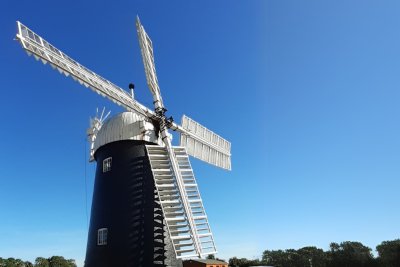Sustain / Real Bread Campaign / Articles
Tuxford Windmill: Sails of the (nineteenth) century
Who that dreams of buying a windmill actually does so? That small group includes Fari Wyman and her husband Paul.

Returning on an overnight flight from holiday in 2004, my husband Paul mumbled in his sleep: “I know what I want, I want a windmill.” I looked over from watching an in-flight movie (with no windmills in it) but he was still fast asleep. I was starting a new job two days later, and was busy planning my first week, but by the end of it we were looking for a windmill to buy.
We found a 19th century mill north of Newark in Nottinghamshire. Six months later, in April 2005, we sold our home and bought it. We called it Tuxford Windmill because it sits on the edge of that town. It is a tower mill that, together with the post mill that was also on the site, was one half of The Tuxford Twins. The post mill was unique in the country as it was the only one rotating with a fantail. What made it even more special was that it had two fantails instead of one. Both mills ceased to function in the early 20th century when industrial mills became dominant. The post mill was demolished in 1950 but the Ostick family (the previous owners) restored the tower mill in 1995.
Learning curve
Neither of us came from a milling or baking background. Paul was an IT and mail order director, and I was an HR manager. On a very steep learning curve, we took on the challenge despite the financial risks and family responsibilities. Paul quickly learned how to mill, and I had to learn how to bake and run a tearoom. Soon we began selling the flour onsite, at local farmers’ markets and through farm shops. Four years later, we extended the tearoom, which had become very popular. We tried various ways to calm the trade to a manageable level but to no avail. Then came Covid 19 and we closed its doors. With the crazy demand for flour during the pandemic, Paul and I decided to change our business model and focused mainly on milling.
Learning about grains and flour was top priority from the first day we bought the windmill. Understanding the difference between strong/bread and soft/plain flour, stoneground and regular (roller milled) flour, and why some flours don’t make good bread, were key to our business. The list was/is long, fascinating, and remains an area for continued discovery. We are mesmerised by the differences in the flours from different grains. They all have their own beautiful aroma and varying shades of cream. Some need more water, some prove quicker, some make great pastry, whilst others make lovely bread. Even the same grain can behave differently in a bake from one harvest to another!
Bread for life
The love of flour and bread were instilled in me as a child. My paternal grandparents were farmers, devoted to arable, dairy, and animal husbandry. We used to see them during school holidays. There were no mills near them, so to make bread they milled their own grain. Making bread was a two-day operation. Paul’s great grandpa was a baker. Paul’s grandma (who lived to the age 106) lived with her family next to the bakehouse in a village called Ampney Crusis, just outside Cirencester.
Bread (or industrial product sold as bread) is a staple of most people’s diet. Whether it’s a tin or cottage loaf; unleavened flatbread or made by the sourdough process, what goes into that bread is key to the health of our digestive system. A few years ago, a friend gave us a copy of Andrew Whittley’s book Bread Matters. Paul and I were shocked at the long list of additives that go into mass-produced flours and industrial dough products, some without having to be declared on the labels. As you’re reading this article, you’re probably already aware of this issue as raised by the Real Bread Campaign and their efforts to change the labelling laws.
A matter of choice
It's two decades since we bought the windmill, in which time the most important point we’ve learned is having a healthy diet. We believe that eating freshly-made food contributed to the longevity of grandma’s life and that of a few other elderly friends we got to know during our life here.
We intend to stay local, and so don’t offer a mail-order service, but there are plenty of mills (water, wind, or electric) around the UK producing great quality stoneground flour. The quality of the grain is most important. The number one choice is organic, followed by grains grown at a ‘minimum input’ farm. Once milled, avoid flours that contain enhancers, preservatives or other non-mandatory additives. If you shop directly from a mill, don’t be shy asking if they mill the flour themselves and where they buy their grain from.
Making bread is a life-skill, which can easily become a weekly or bi-weekly home-routine. You don’t need a fancy oven. Most standard domestic ovens have room to bake three tin loaves in one go, saving on time and your energy bill. Once cooled, you can tuck into one, while slicing and freezing the other two. You’ll be eating toast and sandwiches without unwelcome additives.
We invite independent mills to add their details to the Real Bread Map on our website. The Brockwell Bake Association has a dedicated map of mills in the UK that produce stoneground flour, some of which are members of the Traditional Cornmillers Guild.
Originally published in True Loaf magazine issue 60, July 2024.
Published Monday 5 May 2025
Real Bread Campaign: Finding and sharing ways to make bread better for us, our communities and planet.

